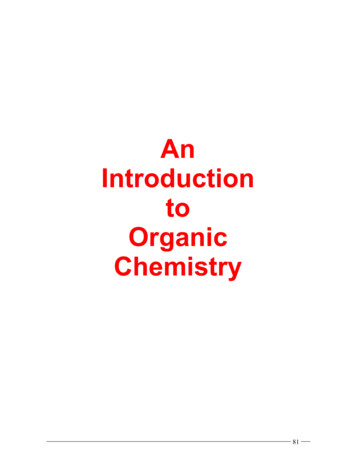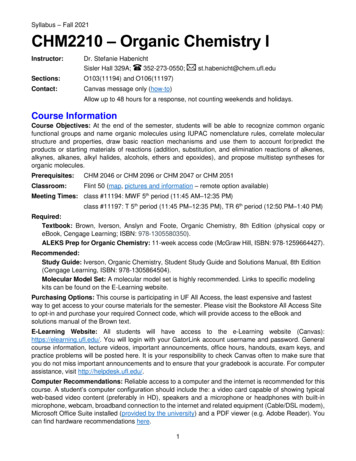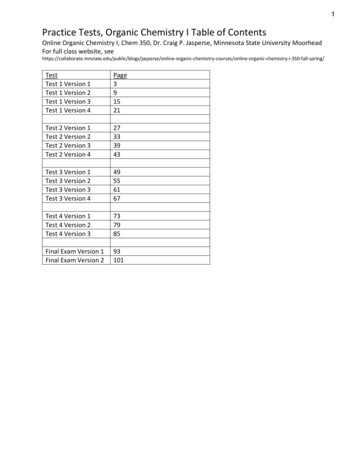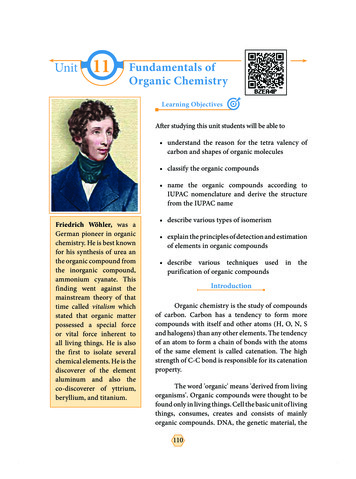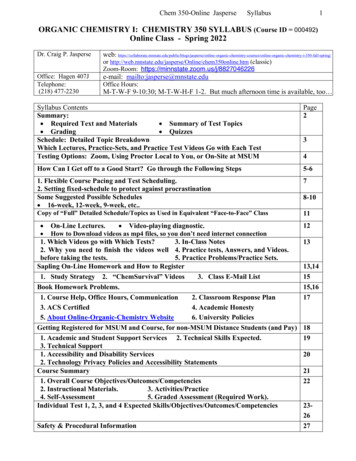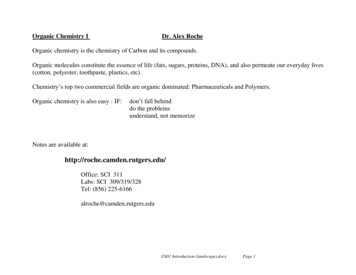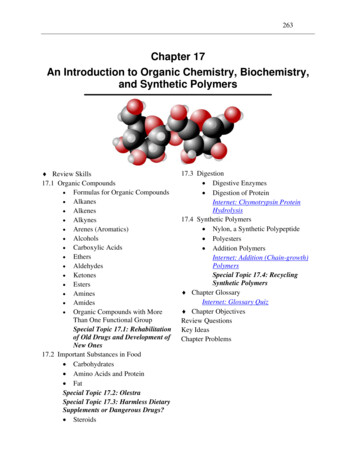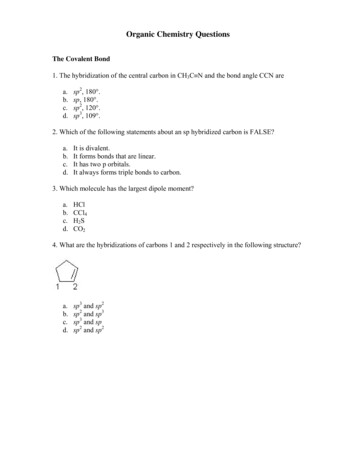
Transcription
Organic Chemistry QuestionsThe Covalent Bond1. The hybridization of the central carbon in CH3C N and the bond angle CCN area.b.c.d.sp2, 180 .sp, 180 .sp2, 120 .sp3, 109 .2. Which of the following statements about an sp hybridized carbon is FALSE?a.b.c.d.It is divalent.It forms bonds that are linear.It has two p orbitals.It always forms triple bonds to carbon.3. Which molecule has the largest dipole moment?a.b.c.d.HClCCl4H2SCO24. What are the hybridizations of carbons 1 and 2 respectively in the following structure?a.b.c.d.sp3 and sp2sp2 and sp3sp3 and spsp2 and sp2
5. What are the hybridizations of atoms 1 and 2 respectively in the following structure?a.b.c.d.sp3 and sp2sp2 and sp3sp3 and spsp2 and sp26. Identify the orbital hybridization at the two indicated carbons in the molecule below.a.b.c.d.C1: sp; C2: spC1: sp2; C2: sp2C1: sp; C2: sp2C1: sp2; C2: sp7. How many total resonance structures can be drawn for the following anion (includethose without separation of charge)?a.b.c.d.1234
8. How many resonance structures can be drawn for the following molecule?a.b.c.d.14329. The correct geometry around oxygen in CH3OCH3 isa.b.c.d.linear.bent.tetrahedral.trigonal planar10. Determine the relationship between the two molecules shown.a.b.c.d.constitutional isomersenantiomersdiastereomersidentical molecules11. What is the correct name for this obutane(2R,3S)-2-bromo-3-chlorobutane
12. What is the specific rotation 20[α ]D of the following molecule?a.b.c.d. 4.42o 0.442o 44.2o– 44.2o13. Which of the following physical properties differ for each of a pair of enantiomers?a.b.c.d.solubility in ethanoldirection of rotation of plane-polarized lightboiling point and melting pointindex of refraction14. Determine the double bond stereochemistry (E or Z) for the following molecules.a.b.c.d.A: E; B: EA: Z; B: ZA: E; B: ZA: Z; B: E
15. Determine the double bond stereochemistry (E or Z) for the following molecules.a.b.c.d.A: E; B: EA: Z; B: ZA: E; B: ZA: Z; B: EMolecular Structure and Spectra1. A strong signal at 1700 cm–1 in an IR spectrum indicates the presence of a(n)a.b.c.d.alcoholethercarbonylamine2. A strong signal at 3400 cm–1 in an IR spectrum indicates the presence of a(n)a.b.c.d.alcoholethercarbonylamine
3. Deduce the structure of an unknown compound with molecular formula C5H12O usinginformation given by its infrared spectrum.Intensity (peak):mmmmmma.b.c.d.Frequency (cm–1):330029002800146514501375
4. Deduce the structure of an unknown compound with molecular formula C9H10O usinginformation given by its infrared spectrum.Intensity (peak):smmsm-wm-wmmma.b.c.d.Frequency (cm–1):310029002800171016001475146514501375
5. Deduce the structure of an unknown compound with molecular formula C5H8O usinginformation given by its infrared spectrum.Intensity (peak):mmsm-wmmFrequency (cm–1):310028001705164014501375a.b.c.d.6. Which of the following compounds a–d has an IR absorption at 3300 cm–1?a.b.c.d.abcd
7. When an external magnetic field is applied, what happens to the protons in a sample?a.b.c.d.All protons align with the field.All protons align opposite to the field.Some protons align with the field and some align opposite to it.All protons assume a random orientation8. Which of the following compounds has the MOST deshielded protons?a.b.c.d.CH3ClCH3ICH3BrCH49. Arrange the following compounds in order of decreasing chemical shift for theunderlined hydrogens (largest δ value first, smallest value last).CH3CH2CH3 CH3OCH2CH3 Cl2CHCH2CH3 ClCH2CH2CH3abcda.b.c.d.b c a db c d ac b a dc b d a10. An unknown molecule A has 4 signals in the 1H NMR spectrum. Which of thefollowing corresponds to molecule A?a.b.c.d.
11. Deduce the structure of an unknown compound using the following 1H NMRspectrum, mass spectroscopy data, and IR spectrum.1H NMR spectrum:δ1.30 (triplet, 6H)δ4.29 (quartet, 4H)δ 7.4–7.9 (multiplet, 4H)Mass Spectrum:m/e: Intensity: (as % of base peak)22210%17738%149100%IR Spectrum:Intensity (peak):smmsm-wm-wmmmsa.b.c.Frequency ��1000
d.12. A compound of formula C5H12 gives 1 signal in the 1H NMR and 2 signals in the 13CNMR. The compound ne.Cannot tell without more information.13. How many methyl peaks would you expect to observe in the 1H NMR spectrum ofcis-1,4-dimethylcyclohexane?a.b.c.d.1234
14. An unknown compound A has the molecular formula C4H8O2. Based on thefollowing 1H NMR spectrum, what is the structure of compound A?a.b.c.d.
15. The 1H NMR spectrum of a compound is shown below. What is the structure of thecompound?a.b.c.d.
16. How many absorption bands will appear in the 13C NMR spectrum for the followingcompound?a.b.c.d.467817. How many absorption bands will appear in the 13C NMR spectrum for the followingcompound?a.b.c.d.578918. Not only the molecular ion peak, but all peaks in the mass spectrum of chlorobenzeneare accompanied by a smaller peak one mass unit higher. This peak is due to which of thefollowing?a.b.c.d.capture of an H atompresence of a 13Cpresence of a 36Clcapture of a proton19. What is the exact mass (in atomic mass units: C, 12.0000; H, 1.0078; N, 14.0031; O,15.9949) of the molecular ion of a compound with molecular formula C3H8O?a.b.c.d.60.000060.057360.062459.9949
Separations and Purifications1. Which of the following may be separated by ordinary physical methods?a.b.c.d.a pair of identical moleculesa pair of enantiomersa pair of diastereomersa pair of identical atoms2. Which of the following may be separated by ordinary physical methods?a.b.c.d.(R)-3-bromo-1-butene and (S)-3-bromo-1-butenecis-2-bromo-2-butene and trans-2-bromo-2-butene(2R,3S)-1,2-dibromobutane and (2S,3R)-1,2-dibromobutane(R)-2-bromobutane and (S)-2-bromobutaneHydrocarbons1. Place the following structures properly on the (abbreviated) energy surface forcyclohexane ring reversal.a.b.c.d.1 b or c, 2 a, 3 d, 4 b or c1 d, 2 b or c, 3 d, 4 a1 d, 2 b or c, 3 a1 b or c, 2 d 3 a, 4 b or c
2. Which of the following cyclohexane conformations has the MOST energy (is theLEAST stable)?a.b.c.d.chairhalf-chairboattwist-boat3. Which of the following molecules is trans-1, 2-dimethylcyclohexane?a.b.c.d.4. What is the IUPAC name of the following lohexaneDimethylcyclohexane1,3-dimethylcyclohexane
5. Which compound has the highest melting -trimethylpentane4-methylnonane6. Which of the following alkanes will have the lowest boiling point?a.b.c.d.7. Which of the following cycloalkanes has the MOST strain ycloheptane8. The balanced equation for the combustion of pentane isa.b.c.d.4 C5H12 2 O2 20 CH4 4 H2O2 C3H8 O2 ? CH4 2 H2OC5H12 8 O2 5 CO2 6 H2OC3H8 5 O2 3 CO2 4 H2O
9. Which of the following is the most stable radical?a.b.c.d.
10. What is the major product of the following reaction?a.b.c.d.
11. What is the major product of the following reaction?a.b.c.d.12. Which of the following occurs during the initiation stage of a radical mechanism?a.b.c.d.Nonradicals are formed from radicals.Radicals are formed from other radicals.Radicals are formed from nonradicals.Nonradicals are formed from other nonradicals.
13. What is the product of the following reaction?a.b.c.d.14. Which version of the radical halogenation of an alkane is MOST ioniodinationOxygen-containing Compounds1. Which of the following will NOT convert 1-butanol into 1-chlorobutane in one step?a.b.c.d.SOCl2PCl3HClCCl4
2. Give the major product of the following reaction.a.b.c.d.3. The Williamson ether synthesis produces ethers by reacting ana.b.c.d.alcohol with a metal.alkoxide with a metal.alkoxide with an alkyl halide.alkyl halide with an aldehyde.4. Ozonolysis (O3 in CH2Cl2) of compound A under reducing conditions (Zn /acetic acid)gives formaldehyde, 2-butanone, and compound B. Catalytic hydrogenation (H2/Pd) of Agives 2,7-dimethylnonane. What is a possible structure for compound -1,7-nonadiene5. Predict the major product of the following reaction.a.b.c.d.m-chlorophenolo-chlorophenol and p-chlorophenolo-hydroxytoluene and p-hydroxytoluenem-hydroxytoluene
6. Which of the following compounds does NOT give a tertiary alcohol upon reactionwith methylmagnesium bromide?a.b.c.d.3-methylpentanalethyl benzoate4,4-dimethylcyclohexanone4-heptanone7. Which of the following compounds gives a secondary alcohol upon reaction withmethylmagnesium bromide? Assume the usual acid workup.a.b.c.d.butyl formate3-pentanonepentanalmethyl butanoate8. Predict the product of the following ol enantiomer(R)-1,2,2-trimethylcyclohexanol enantiomer(1S,2S)-2,3,3-trimethylcyclohexanol enantiomer(1R,2S)-2,3,3-trimethylcyclohexanediol enantiomer9. Which of the following statements about organometallic compounds is FALSE?a.b.c.d.Alkyllithium reagents (RLi) add to the carbonyl group of aldehydes and ketones.Grignard reagents (RMgBr) add to the carbonyl group of aldehydes and ketones.Alkyllithium and Grignard reagents do not add to esters.Grignard reagents are prepared in ether or tetrahydrofuran (THF).
10. What is the name of the following compound?a.b.c.d.Ethyl cyclohexyl etherHexyl propyl ether1-EthoxycyclohexaneCyclohexyl propyl ether11. What is the major product formed in the following synthesis?a.b.c.d.
12. Which is the correct IUPAC name for the following ethyl-1-hexanol2,5,6-Trimethyl-2-heptanol13. What is the correct name of the following compound?a.b.c.d.3-methylbenzoic 14. What is the correct name of the following -cycloheptenone3-cyclohexen-1-one
15. Predict which of the following compounds will have a lower boiling point than c acid16. Predict the product of the following reaction. PhCH2OH PCC (pyridiniumchlorochromate) in methylene chloride a.b.c.d.benzophenonebenzoic acidbenzaldehydebenzyl chloride17. What is a proper name for the following ester?a.b.c.d.2-butyl ethylesterethyl 2-pentanoateethyl 2-methylbutanoatemethylbutanoic ethyl ester18. The correct IUPAC name for ester B nzyl 2-methyl-4,4-dimethylpentanoatebenzyl 2,4,4-trimethylpentanoatebenzyl 2,4,4-trimethylbutanoate.
19. What is the acid anhydride that is hydrolyzed?a.b.c.d.
20. What is the product of the following reaction?a.b.c.d.
21. What are the two possible tautomers for the following ketone?a.b.c.d.
22. Which of the following compounds is the product of an aldol condensation reaction?a.b.c.d.Amines1. What is the sequence of reagents that will accomplish the synthesis of the followingaromatic amine from benzene?a.b.c.d.CH3Cl, AlCl3; HNO3, H2SO4; H2CH3Cl, AlCl3; HNO3, H2SO4; Fe, HCl; NaOHHNO3, H2SO4; Fe, HCl; NaOH; CH3Cl, AlCl3HNO3, H2SO4; CH3Cl, AlCl3; Fe, HCl; NaOH
2. Which of the following aniline derivatives is the strongest base?a.b.c.d.
3. What is the product of the following reaction?a.b.c.d.
4. What is the name of the following hylpropylamin5. Which of the following amines is a tertiary amine?a.b.c.d.
6. What is the product of the following synthesis?a.b.c.d.7. Supply the correct words to complete this sentence: Electron-withdrawing groups suchas nitro the basicity of anilines, especially when substituted.a.b.c.d.increase ; ortho or paraincrease ; metadecrease ; ortho or paradecrease ; meta
Biological Molecules1. Which of the following amines is pyridine?a.b.c.d.2. Which of the following statements is NOT true regarding fatty acids?a.b.c.d.Fatty acids dissolve in nonpolar solvents.Triglycerides are esters of fatty acids.Most naturally occurring fatty acids have trans double bonds.Fatty acids are biosynthesized from acetate.3. Which of the following statements regarding the biosynthesis of cholesterol is FALSE?a. Cholesterol has the same carbon skeleton as its biosynthetic precursor, lanosterol.b. Cholesterol is derived from the dimerization of farnesyl pyrophosphate in a headto-head manner.c. Cyclization of squalene to cholesterol is initiated by acid-catalyzed ring openingof an epoxide.d. Cholesterol has three fewer carbon atoms than lanosterol.
4. Which of the following represents the structure of a triacylglyceride?a.b.c.
d.5. Which of the following compounds does NOT undergo . Which statements are correct about the following disaccharide?a. Ring A is an acetal in the α configuration; ring B is a hemiacetal in the ßconfiguration.b. Ring A is an acetal in the ß configuration; ring B is a hemiacetal in the αconfiguration.c. Ring A is a hemiacetal in the α configuration; ring B is an acetal in the ßconfiguration.d. Ring A is a hemiacetal in the ß configuration; ring B is an acetal in the αconfiguration.
7. A glycoside is the carbohydrate form of ana.b.c.d.ether.acetal.aglycone.alcohol.8. Which of the following amino acids is achiral?a.b.c.d.alanineglycineserinecysteine9. Which of the following is NOT a part of the primary protein structure?a.b.c.d.the amino acid sequencethe disulfide linkagesthe planar nature of the amide linkagethe conformation of the polypeptide backbone10. Which of the following statements about the conformation (secondary and tertiarystructure) of proteins is FALSE?a. The four atoms of an amide linkage (–CO–NH–) lie in a plane as a result ofresonance between the nitrogen and the carbonyl group.b. Electrostatic attraction occurs between basic and acidic side chains.c. The favored conformation of a protein is always that which has the greatestnumber of hydrogen bonds.d. The presence of the amino acid proline has the effect of turning a corner in aprotein.11. Which of the following statements about an enzyme is FALSE?a.b.c.d.An enzyme is usually a large protein.An enzyme is a catalyst for biological reactions.An enzyme is a chiral molecule.An enzyme changes the equilibrium constant of a reaction.12. Which of the following statements about the arrangement of a protein in threedimensions is FALSE?a. As a result of hydrogen bonding, a portion of a protein may exist as a righthanded α-helix with 3.6 amino acid residues per turn, and a repeat unit of 5.4 Å.b. As a result of hydrogen bonding a portion of a protein may exist as a pleatedsheet, in which the repeat unit is 7.0 Å.c. In a pleated sheet, the polyamide chains may be parallel or antiparallel.d. A portion of a protein may exist as a flat sheet with a repeat unit of 7.2 Å.
13. Which of the following is NOT an example of secondary structure found in proteins?a. ß-pleated sheetb. α-helixc. hydrophobic foldingd. random coil14. Which descriptors fit the following sugar best?a.b.c.d.ketose, furanose, αketose, furanose, ßaldose, pyranose, ßaldose, pyranose, a
15. Where are the isoprene subunits in the following terpene?a.b.c.d.
16. Which of the following tetracyclic compounds corresponds to the typical 17-carbonsteroid nucleus?a.b.c.d.
17. Which of the following is a steroid?a.b.c.d.
Organic Chemistry AnswersThe Covalent Bond1. (b)2. (d)3. (a)4. (a)5. (d)6. (d)7. (d)8. (c)9. (b)10. (b)11. (d)12. (c)13. (b)14. (d)15. (b)Molecular Structure and Spectra1. (c)2. (a)3. (c)4. (b)5. (c)6. (a)
7. (c)8. (a)9. (b)10. (c)11. (d)12. (c)13. (a)14. (a)15. (a)16. (d)17. (c)18. (b)19. (b)Separations and Purifications1. (c)2. (b)Hydrocarbons1. (a)2. (b)3. (d)4. (d)5. (b)6. (c)7. (a)
8. (c)9. (a)10. (d)11. (a)12. (c)13. (a)14. (c)Oxygen-containing Compounds1. (d)2. (b)3. (c)4. (c)5. (c)6. (a)7. (c)8. (c)9. (c)10. (d)11. (b)12. (d)13. (a)14. (d)15. (c)16. (c)17. (c)
18. (c)19. (c)20. (c)21. (d)22. (c)Amines1. (b)2. (b)3. (c)4. (a)5. (c)6. (c)7. (c)Biological Molecules1. (c)2. (c)3. (a)4. (c)5. (b)6. (a)7. (b)8. (b)9. (d)10. (c)
11. (d)12. (d)13. (c)14. (b)15. (c)16. (c)17. (b)
Organic Chemistry Questions The Covalent Bond 1. The hybridization of the central carbon in CH3C N and the bond angle CCN are a. sp2, 180 . b. sp, 180 . c. sp2, 120 . d. sp3, 109 . 2. Which of the following statements about an sp hybridized carbon is FALSE? a. It is divalent. b. It
